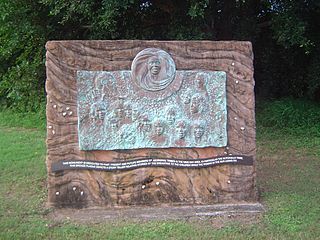The Goreng Goreng, also known Kooreng Gooreng, are an inland Freshwater Australian Aboriginal people of Queensland, and also a language group. The Goreng Goreng area is between Central West Queensland in the north around Boyne Valley, extending westerly as far as the Great Dividing Range along the Dawes, Auburn, Nogo and Callide Ranges to meet the Wulli Wulli and Ghunghulu to their immediate west over the Great Dividing Range.

Caloundra is a coastal town and the southernmost town in the Sunshine Coast Region in South East Queensland, Australia.

Bribie Island is the smallest and most northerly of three major sand islands forming the coastline sheltering the northern part of Moreton Bay, Queensland, Australia. The others are Moreton Island and North Stradbroke Island. Bribie Island is 34 kilometres long, and 8 kilometres at its widest. Archibald Meston believed that the name of the island came from a corruption of a mainland word for it, Boorabee. meaning 'koala'. However, the correct Joondaburri name for the island is in fact Yarun.

The Gubbi Gubbi people are an Aboriginal Australian people native to south-eastern Queensland. They are now classified as one of several Murri language groups in Queensland.

Andrew Petrie was a pioneer, architect and builder in Brisbane, Queensland, Australia.

Thomas Petrie was an Australian explorer, gold prospector, logger, and grazier.
The Turrbal are an Aboriginal Australian people from the region of present-day Brisbane, Queensland. The name primarily referred to the dialect they spoke, the tribe itself being alternatively called Mianjin/Meanjin. Mianjin was the Turrbal word for the central Brisbane area. The traditional homelands of the Turrbal stretch from the North Pine River, south to the Logan River, and inland as far as Moggill, a range which includes the city of Brisbane.

The Jagera people, also written Yagarr, Yaggera, Yuggara, Yuggera, Chepara-Yuggara, Chepara-Yugara, Ugarapul, Yugarabul, Yuggarapul, and Yugarapul are the Australian Aboriginal people who spoke the Yuggera language. The Yuggera language which encompassed a number of dialects was spoken by the traditional owners of the territories from Moreton Bay to the base of the Toowoomba ranges including the city of Brisbane and Ipswich. The groups who spoke dialects of the Yuggera language that lived in the region include the Turrbal People, Jagera People, Yugara People, Yuggera Ugarapul People, Jagera Yagera Gurrangnam.

A jackaroo is a young man working on a sheep or cattle station, to gain practical experience in the skills needed to become an owner, overseer, manager, etc. The word originated in Queensland, Australia in the 19th century and is still in use in Australia and New Zealand in the 21st century. Its origins are unclear, although it is firmly rooted in Australian English, Australian culture and in the traditions of the Australian stockmen.
The Yidiny, are an Aboriginal Australian people in Far North Queensland. Their language is the Yidiny language.

The Yugambeh are an Aboriginal Australian people of south-east Queensland and the Northern Rivers of New South Wales, their territory lies between the Logan and Tweed rivers. They are alternatively known as the Minyungbal. A term for an Aboriginal of the Yugambeh tribe is Mibunn, which is derived from the word for the Wedge-tailed Eagle. Historically, some anthropologists have erroneously referred to them as the Chepara, the term for a first-degree initiate. Archaeological evidence indicates Aboriginal people have occupied the area for tens of thousands of years. By the time European colonisation began, the Yugambeh had a complex network of groups, and kinship. The Yugambeh territory is subdivided among clan groups with each occupying a designated locality, each clan having certain rights and responsibilities in relation to their respective areas.
The Kombumerri clan are one of nine distinct named clan estate groups of the Yugambeh people and the name refers to the Indigenous people of the Nerang area on the Gold Coast, Queensland. Australia
The Ngugi are an Aboriginal Australian people, one of three Quandamooka peoples, and the traditional inhabitants of Moreton Island.
The Djindubari, also written Jindoobarrie or Joondubarri, were an indigenous Australian people of southern Queensland, whose traditional lands were located on Bribie Island. They are thought to be a horde or clan of the Undanbi.
The Dalla, also known as Jinibara, are an indigenous Australian people of southern Queensland whose tribal lands lay close to Brisbane.
Dundalli was an Aboriginal lawman who figured prominently in accounts of conflict between European settlers and indigenous aboriginal peoples in the area of Brisbane in South East Queensland. Traditionally described as a murderer, savage and terrorist, he is now thought variously to have been a guerilla leader or to have coordinated a decade-long resistance to white colonization the area. He was hanged publicly in Brisbane in 1855 by order of the Sheriff of New South Wales.
The Nunukul, also spelt Noonuccal and known also as Moondjan are an Aboriginal Australian people, one of three Quandamooka peoples, who traditionally lived on Minjerribah, in Moreton Bay Area and in mainland Brisbane regions.

The Butchulla, also written Butchella, Badjala, Badjula, Badjela, Bajellah, Badtjala and Budjilla are an Aboriginal Australian people of K'gari, Queensland, and a small area of the nearby mainland of southern Queensland.
The Goenpul, also written Koenpal, are an Aboriginal Australian people, one of three Quandamooka peoples, who traditionally lived on the southern part of Stradbroke Island in southern Queensland. Today their preferred term for their group is Dandrubin Gorenpul.
The Kaiabara are an indigenous Australian people of the state of Queensland. Rather than an independent tribe, they may have been a horde of the Wakka Wakka.